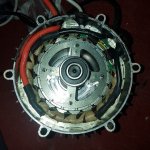Ianhill
1 MW
- Joined
- Sep 25, 2015
- Messages
- 2,871
Hummina Shadeeba said:I think iron will be needed in this motor at least for the great increase in magnetic strength it brings. But the casted zinc? I’ll be seeing what resin I can find that could be vacuumed into the winding first and hopefully not breakdown w the heat of the casting.
650c. Almost heat resilient enough to cast aluminum around
https://www.cotronics.com/vo/cotr/pdf/4703.pdf
Even better possibly
http://www.flexibleceramics.net/high-temp-resin.html
Maybe best to not have any lower temp enamel on the wire which would maybe transform badly with the heat.
Iron does not increase the total amount of magnetic field it just guides the field lines into a more dense higher tesla area it's like focusing a torch the light does not increase yet it has more lumens at it's peak when zoomed.
I've tried to read what your trying to obtain but I'm getting lost, you want more power handling from filling the tooth slot with solid zinc around the copper ?
Why not use a litz wire and fill the tooth properly then back fill with a diamond carbon that's the best performance you will get from a standard motor.
The core can only take so much induction before it saturates around the tooth and forms hot spots that will be your limiting factor any pics of what you are upto ?




